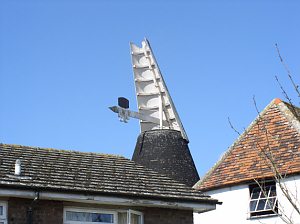 |
A piece of Suffolk's rural heritage
is to be preserved after Babergh District Council decided to break
its own rules and award a grant.
The council is to give £500 towards restoring the wooden cowl
which tops the 16th-century grain drying kiln at W. A. Church's
seed store in Bures.
The cowl, designed to turn with the wind, came off its mountings
in the recent gales and needs to be realigned, while timber and
brickwork require restoration.
The firm also hopes to replace the small wooden model of a beer
barrel which once adorned the cowl's wind vane, signifying its former
role in the brewing trade.
The conical brick kiln, believed to date from around 1530, is one
of a group of buildings listed Grade II at W. A. Church's High Street
premises, a former maltings.There are three similar kilns in the
Babergh area, at Long Melford, Kersey and Little Waldingfield, but
the Bures building is unique in retaining its cowl.
It is also the only kiln in Suffolk still in regular use for the
purpose for which it was intended.
|
|
|
Babergh policy normally excludes
grant aid to privately-owned listed buildings, but in view of the
kiln's unique status the council voted to assist with the estimated
repair costs of £2,866.
Director Mr. John Ineson said the 450-year-old kiln was not a historical
curiosity but an important part of the firm's operations, doing
a job modern machines could not do.
Equipped with electric blowers in its base and a steel mesh floor,
the kiln remains the most efficient way of drying small seeds such
as turnip, kale and clover.
"For small seeds, where the germination temperature is important,
you can dry them much more carefully with this," said Mr.
Ineson.
"We've got modern electric driers at our other plant but
for some jobs the old-fashioned way is still the best."
As recently as the 1940s W. A. Church had three other kilns in Bures
but one blew down in a gale, another had to be demolished and a
third was remodelled to form another seed drying unit, but this
is the last surviving one still in use.~
Babergh planning officer Mr. Mike Crouch said the decision to go
against the council's normal policy was a response to exceptional
circumstances.
"We felt it was to W. A. Church's credit that they had been
prepared to retain the cowl for so long when there were more economic
ways of doing the job," he said.
"As the kiln's a bit of a local landmark and a feature of the
street scene we felt it was worth supporting in this case."
Text taken from EADT
05.07.1990
|
MALTINGS COWL 2011
|
|
Cowl undergoing further restorationduring
July 2011.
21 years since its last repair.
|
|
|
|
Work completed at the end of September
2011.
Unfortunately, due to financial restraints no external grant was available
to assist in the funding of this restoration.
It is a credit to the Directors of Church`s to restore this feature,
so that we may once again enjoy the view of an original Cowl.
Note the beer barrel on the arm to remind
us this Kiln was once used as a Malting
For a more detailed information
on W. A. Church, visit their own web site at
www.churchofbures.co.uk
|


